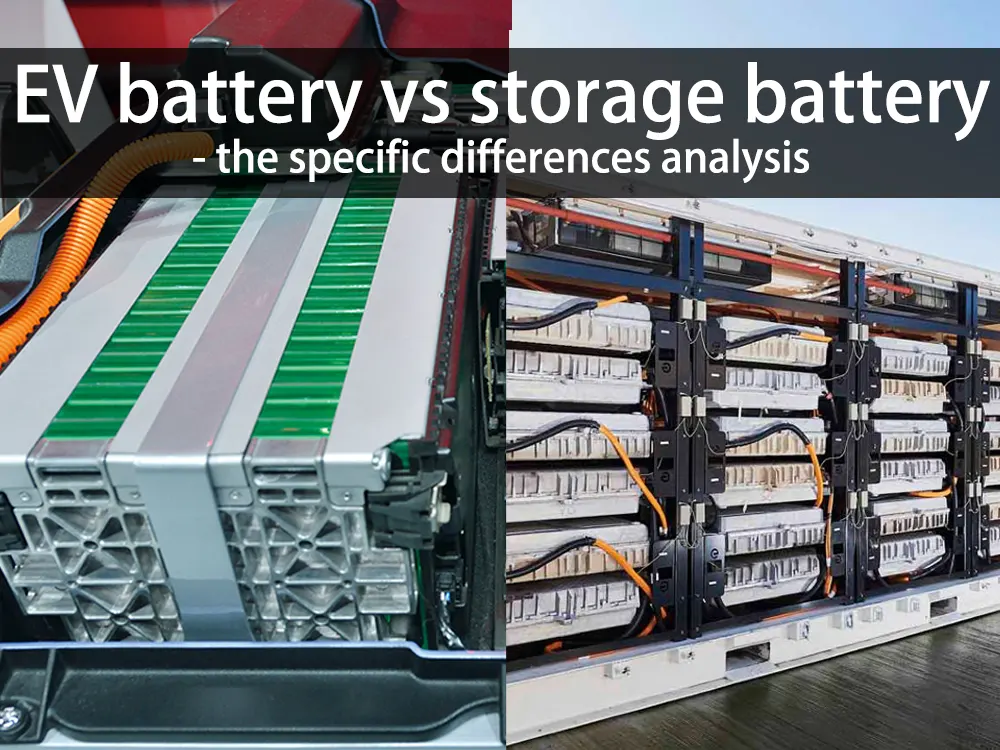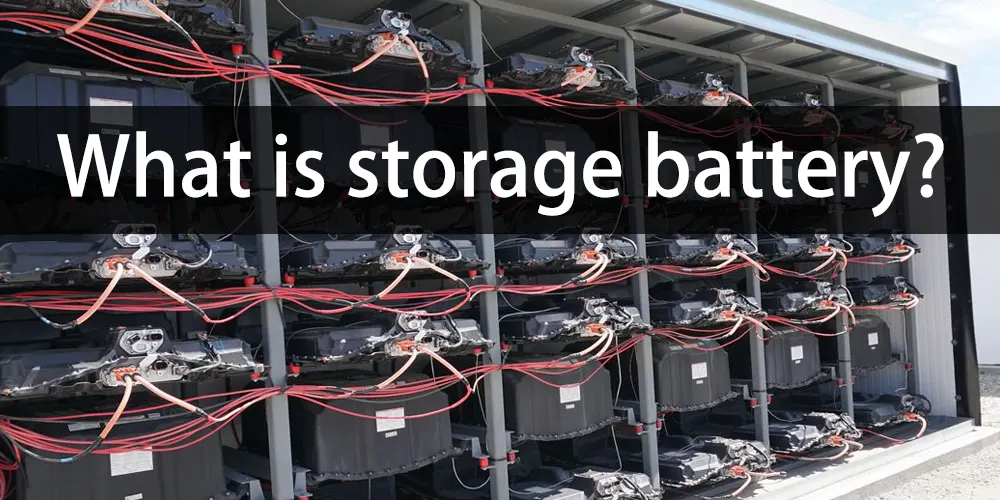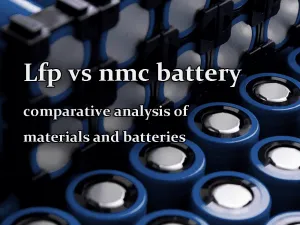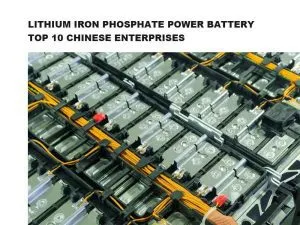EV battery vs storage battery - the specific differences analysis

Compared EV battery vs storage battery, what is the difference between these two batteries? Can they be mixed? This article will give you an introduction and analysis, so that you can better understand the specific differences between EV battery vs storage battery.
What is storage battery?
Storage battery is a battery system used to store electrical energy. Storage batteries convert electrical energy into chemical energy, storing the charge in the battery and releasing it when needed.
Energy storage batteries are usually designed for long-term energy storage and charging and discharging, such as playing an important role in grid dispatching, peak load shaving, and power management. The key features of energy storage batteries are high capacity, long cycle life, and stable performance.
What is EV battery?
EV battery is designed to provide the power required by electric vehicles. EV batteries need to have high energy density and high power output to meet the acceleration performance and driving range requirements of electric vehicles.
The design focus of the EV battery is to improve the charging speed, discharging speed and cycle life of the battery. At the same time, safety is also an important aspect of power batteries to ensure reliable work under various conditions.
What are the differences between EV battery vs storage battery?
The main differences between EV battery vs storage battery are mainly in the following points:
| EV battery | Storage battery | |
| Application scenarios | Electric vehicle | Energy storage power station |
| Power density | The requirements are relatively high, and energy-type batteries with a discharge capacity of about 1C are generally used in consideration of safety | The discharge rate of the capacity type application scene is ≤0.5C; the discharge rate of the power type application scene is ≥2C; the two can be used together |
| Calendar lifespan | 5-10 years | Over 10 years |
| Cycle life | 2000 cycles | 5000 cycles or more than |
| Main cell | Lithium iron phosphate battery cell and ternary battery cell | Lithium iron phosphate battery cell is the main |
Application scenarios
Storage batteries are widely used in grid energy storage, home energy storage, industrial and commercial energy storage, communication base stations and other fields. The design requirements of energy storage batteries are mainly optimized for energy density and long-term storage to meet the demand for high-capacity and long-lasting energy storage.
Since most of the energy storage devices of storage batteries do not need to be moved, compared EV battery vs storage battery, there is no direct requirement for energy density of energy storage lithium batteries. Different energy storage scenarios have different requirements for power density.
In terms of battery materials, attention should be paid to expansion rate, energy density, uniformity of electrode material performance, etc., in order to pursue long life and low cost of the entire energy storage device.
EV batteries are used in new energy passenger vehicles, commercial vehicles, special vehicles, construction machinery and equipment, ships such as lithium ion marine battery, etc. Comparing EV battery vs storage battery, EV batteries pay more attention to power density and short-term high power output to meet the needs of electric vehicles for fast acceleration and long mileage.
Compared with EV battery vs storage battery, EV batteries as power batteries have higher requirements on energy density and power density. Furthermore, since the power battery is limited by the size and weight of the vehicle and the acceleration when starting, the power battery has higher performance requirements than the ordinary energy storage battery.
System composition
The power battery PACK is basically composed of the following five systems: battery module, battery management system, thermal management system, electrical system and structural system. The cost of the power battery system consists of comprehensive costs such as batteries, structural parts, BMS, boxes, auxiliary materials, and manufacturing costs. The batteries account for about 80% of the cost, and the cost of the battery pack accounts for about 20% of the entire battery pack cost.
Different from EV battery vs storage battery, the energy storage battery system is mainly composed of battery pack, battery management system (BMS), energy management system (EMS), energy storage converter (PCS) and other electrical equipment.
In the cost structure of the energy storage system, the battery is the most important part of the energy storage system, accounting for 60% of the cost. The second is energy storage inverters, accounting for 20%, EMS (energy management system) costs account for 10%, BMS (battery management system) costs account for 5%, and others account for 5%.
Battery management system
As the core component of the battery system, BMS (battery management system) determines whether the various components and functions of the battery pack can be coordinated, and is directly related to whether the battery pack can provide power output for electric vehicles safely and reliably.
The energy storage battery management system is similar to the power battery management system. However, the power battery system is in a high-speed electric vehicle, and there are higher requirements for the power response speed and power characteristics of the battery, SOC estimation accuracy, and the number of state parameter calculations. The relevant adjustment functions also need to be realized through the BMS.
Cycle life
EV battery vs storage battery have different service life requirements. Energy storage batteries usually need to have a longer cycle life and be able to withstand thousands of charge and discharge cycles without significantly reducing performance.
Taking an electric two-wheeled vehicle as an example, the theoretical lifespan of a ternary lithium battery pack is 1,200 times. According to the usage frequency of fully charging and discharging once in three days, the lifespan of a ternary lithium battery can reach ten years.
Compared with EV battery vs storage battery, energy storage batteries are charged and discharged more frequently, and have higher requirements for cycle life under the premise of the same 10-year lifespan.
If the energy storage power station and household energy storage are charged and discharged once a day, the cycle life requirement of the energy storage lithium battery can be greater than 3,500 times. If the charge and discharge frequency is increased, the cycle life requirement is usually required to reach more than 5,000 times.
Battery cost
Cost is also one of the differences between EV battery vs storage battery. The cost of energy storage batteries is relatively low because it uses more mature battery technology, and the application conditions are relatively simple, which can achieve economic benefits in large-scale applications.
In contrast, the high cost of power batteries is mainly due to the requirements for high energy density and high power output, long life and high safety requirements for compatible batteries.
Can storage batteries and EV batteries be mixed?
Comparing EV battery vs storage battery, storage batteries cannot be used in electric vehicles. There are different rates, different internal resistances, different capacities, and different voltages between the two. Energy storage batteries generally have higher energy density, but lower power density. For example, if 280 exceeds 0.5C, the temperature will be too high, so the energy storage battery cannot be used as a power lithium battery.
The power lithium battery can be used as an energy storage battery. It is necessary to understand the design and configuration of the control system for the discharge of the lithium battery. However, both the power battery and the power control system have high cost factors, which will lead to less than ideal economic benefits.
It is understood that storage lithium batteries also have a power type, such as supporting a stable current discharge capacity of about 5C, which is widely used in frequency modulation. Some companies will use the decommissioned power batteries as energy storage batteries for secondary use, and apply them to home energy storage and mobile energy storage




























